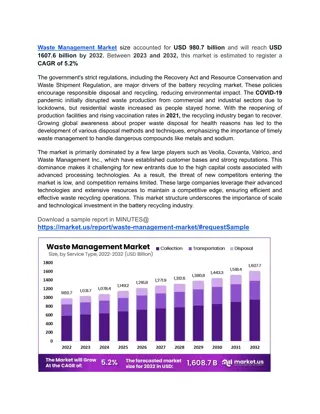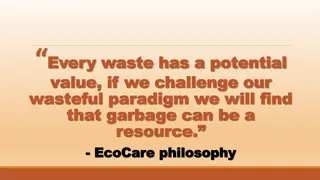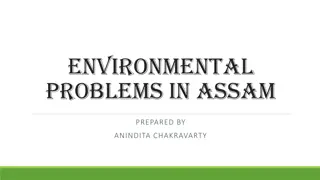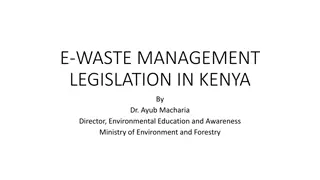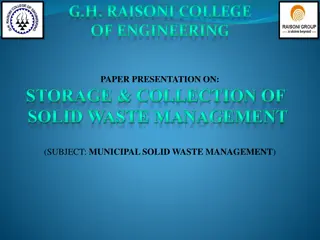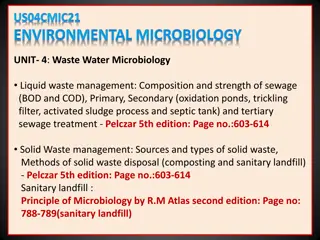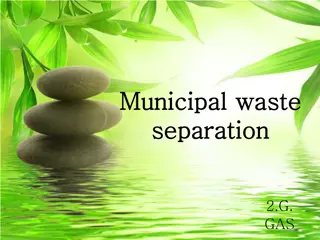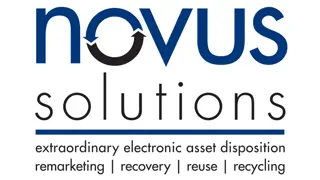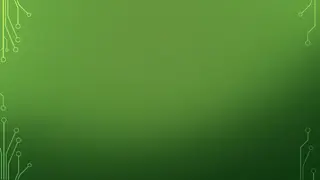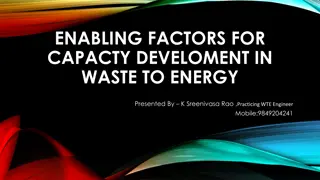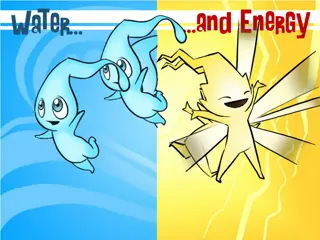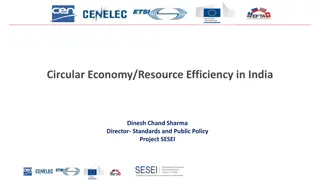Waste Management Challenges and Solutions in India
Waste generation is a growing concern in India due to rapid urbanization and changing consumption patterns. This article explores the types of waste, sources, and the magnitude of the waste problem in India. It also discusses the public health importance of waste management, current challenges faced, and ideal waste management practices required for a sustainable future.
Download Presentation

Please find below an Image/Link to download the presentation.
The content on the website is provided AS IS for your information and personal use only. It may not be sold, licensed, or shared on other websites without obtaining consent from the author.If you encounter any issues during the download, it is possible that the publisher has removed the file from their server.
You are allowed to download the files provided on this website for personal or commercial use, subject to the condition that they are used lawfully. All files are the property of their respective owners.
The content on the website is provided AS IS for your information and personal use only. It may not be sold, licensed, or shared on other websites without obtaining consent from the author.
E N D
Presentation Transcript
Contents: Introduction Waste Classification Sources Magnitude of the problem Public health importance of waste management Ideal waste management Present status of waste management in India Integrated solid waste management E-waste-effects , sources , mg Hazardous waste Biomedical waste Liquid waste Challenges faced in management of waste conclusion
Introduction: Waste is being generated everywhere. Waste comes from our home, school, college, hospital, market, industries, agriculture and commercial places. Rabid urbanization Constant change in consumption pattern and school behavior Problem of high volumes of waste, the costs involved , the disposal technologies and methodologies, and the impact of wastes on the local and global environment.
Waste: Waste includes all items that people no longer have any use for, which they either intend to get rid of or have already discarded. Any material which is not needed by the owner, producer or processor.
Types of waste on the basis of their physical state: Solid waste Liquid waste Gaseous waste
On the basis of bio- degradability: Biodegradable waste Non- Biodegradable
On basis on effects on human health: Hazarded waste Non hazarded waste
Sources: Residential Commercial Institutional Municipal solid waste Treatment facilities Agriculture
Solid waste: Solid waste is commonly called garbage. It includes only non- liquid waste. Three types of solid waste: House hold or municipal solid waste. Industrial waste or hazardous waste. Hospital waste or biomedical waste.
Magnitude of problem(INDIA): Per capita waste generation increasing by 1.35% annum. With urban population increasing between 3-3.5% per annum. Yearly increasing in waste generation is around 5% annually. Per capita generation of waste varies from 200 gm to 600 gm of the solid waste generated. Crude dumping of waste in most of the cries.
Public health importance of waste management: Poor waste handing and disposal- environmental pollution- breeding of disease vector insects, animal scavengers and rodents- disease. Public or community nuisance due to foul odour and unsightliness. Obstruction of drainage system. Fire hazards.
The ideal waste management system: Provide a customized and robust handling of all waste with a minimum of effort for the customer. Result in the lowest possible load on the environment. Provide a maximum of disease of resource recovery from the waste while minimizing use of resources in the waste handing. Provide only little impact on the city with respect to traffic vehicle exhaust, nose, traffic accidents and spill of waste. Include proper architectural consideration in establishing waste collection facilities. Economically acceptable.
Present status of waste management: Domestic waste thrown on streets. Trade waste on road / streets. Construction debris left unattended . Biomedical waste disposed in municipal waste stream. Industrial waste disposal off in open areas. Segregation and storage of waste at sources not done inappropriate, resulting in littering of garbage. Street sweeping not done in everyday. Waste transportation done in open vehicles. Final disposal done through crude dumping. Rag pickers collect recyclable from municipal bins / dumpsites and litter the waste causing insanitary conditions.
Integrated solid waste management (ISWM): Comprehensive waste prevention, recycling, composition, and disposal program. To minimize the initial generation of waste materials through source reduction, then through reusing and recycling to further reduce the volume of the material being sent to landfills or incineration compared to the conventional approach of simply focusing on disposal of solid waste.
Focus of the ISWM program includes: Assignment of present condition and organizational set up. Reduce, reuse and recycle solid waste to the greatest extend possible. Co- operate to the extend practicable in recycling program conducted by the civilian community. Facilitating ty community participation in solid waste management activity intellectual input- research on design, material, concept. Financial support towards infrastructure and maintenance. Privatize solid waste management facilities or contract for waste disposal services, including recycling. Complying with applicable regulations regarding solid waste management and recycling. Overall monitoring and co-ordination.
Solid waste disposal: On-site disposal. Composting. Incineration. Open dumps. Sanitary landfills.
E waste: E-waste comprises of waste electronics goods which are not fit their originally intended use. Such electronics goods may be television, telephone, radio, computers, printer, fax machines, DVDs and CDs etc. Sources of e-waste : It and telecom equipments. Large and small household appliances. Consumer & lighting equipment. Toys, leisure & sports equipment. Medical devices. Monitoring & control instruments.
Health effects: Electronics products like computers and cell phones contain a lot of differents toxins. Electronic products like computer and cell phone contain a lot of different toxins. For example, cathode ray tubes (CRTs)contain heavy martial such as lead, barium and cadmium, which can damage human nervous and respiratory system if they enter the water system.
Effects of e- waste: On Human Health: On Environment DNA damage. Pollution of ground water. Lung cancer. Acidification of soil. Damage to heart, liver and spleen. Air pollution Chronic damage to the brain. E-waste accounts for 40 percentage of the lead and 75 percent for the heavy metals found in landfills. Asthmatic bronchitis.
E-waste management: The major components of e-waste management are : E-waste collection, sorting and transportation. E-waste recycle. In industries, management of e-waste is done by waste minimization techniques. It involves: Inventory management. Production process modification. Volume reduction. Recovery and reuse.
Hazardous waste: Consist of toxic substances that are chemical nature. Highly dangerous to human, plants, animals and the overall environment.
Hazardous waste management: Minimizing. collection and packaging. Labelling. Storage. Disposal.
Minimizing: Reuse old chemical containers. Helps in resources conservation, economic efficiency & environmental protection. Collection and packaging: Never mix incompatible materials. Sealed containers. Liquid waste containers should only be fill to 75% of expansion. Labeling: Proper labeling
Storage: Waste should be segregated and stored according to compatibility. Make sure container are source and check for leaks in storage area. Treatment: Physical: screening, sedimentation, centrifugation, floatation, adsorption. Chemical: neutralization, precipitation, oxidation and reduction. Biological: different types of microorganisms. Disposal: Incineration- able to achieve 99.99% destruction & removal efficiency of hazardous components in waste. Land disposal, underground disposal & deep well injection.
Biomedical waste: Bio-medical waste means any waste, which is generated during the diagnosis, treatment or immunization of human beings or animals or in research activities or in the production or testing of biologicals. Steps in BMW management: Generation Segregation Storage and collection Transportation Treatment Disposal
Steps in BMW management: Survey of waste generated: Quality Types source Level of disinfection
Segregation and collection: Done at point of generation of waste. Process where wastes of different types, hazardous nature and consisyency are separated. As per the categories. Colour coded containers. Local languages.
Colour coding and types of containers for disposal of bio-medical wastes: Colour coding Types of containers Waste category Treatment options as per schedule : 1 yellow Plastic bag disinfected Disinfection container/plastic bag 1,2,3,6 Incineration/ deep burial red 3, 6, 7 Autoclaving/ micro waving / chemical treatment. Blue/white Plastic bag /puncture 4 , 7 Autoclaving/micro waving/chemical. Black Plastic bag 5, 9, 10(solid) Disposal in second landfill.
Storage of waste: Holding of biomedical waste for such period of time, at the end of which waste is treatment and disposal of. Safe from tampering and access to rag-pickers. Not beyond a period of 48 hours. Biohazard symbol.
Transportation of waste: Vital link. Source - interim storages site - final disposal. Minimal effort, spillage or disturbances to the waste. Frequency and timings of transport should be informed. Keep proper documentation of the frequency.
Technologies for waste treatment: Reduce its bulk and make it free from pathogenic organisms. Changes the physical, chemical or biological characteristics or composition. Hazardous non-hazardous. Chemical disinfection technology. Thermal technology. Mechanical technology. Irradiation technology.
Final disposal methods: Incineration. Deep burial. Landfill.
Liquid waste: Sewage. Sullage. Industrial waste. Runoff.
Sewage: Waste water from the community which contains solid and liquid excreta. 99.9% - water. 0.1 solids.
Sewage management: Basis requirement: Surface water must not be contaminated. There should be no contamination of groundwater that may, contaminate springs or wells. Excreta should not be accessible to files or other animals. There should be no handling of excreta; where this is unavoidable, it should be kept to a minimum. There should be no odours or unsightly conditions. The method used should be simple and inexpensive in construction and operation The method should last for at least five years to be cost-effective.
Waste water management: Physical Chemical Biological Pre-treatment: Pre-treatment removes martials that can be easily collected from the raw waste water before they damage or clog the pumps and skimmers of primary treatment clarifiers (trash, tree limbs, leaves, etc.., Screening and grit removal.
Primary treatment: Primary sedimentation tanks . Settle sludge while grease and oils rise to the surface and are skimmed off. 50-70% of solids settle. Biological action. Complex organic simpler substances. Secondary treatment: Degrade the biological content of the sewage. Aerobic biological processes. Secondary treatment systems are classified as fixed-films or suspended growth systems. Fixed film trickling filters and rotating biological contactors. Suspended growth systems activated sludge.
Challengers: Absence of segregation of waste at source. Lack of technical expertise and appropriate institutional arrangement. Unwillingness LSGI to introduce proper collection, segregation, transportation and treatment/ disposal systems. Lack of management. Lack of planning for waste management while planning towards. Indifferent attitude of citizens towards waste management due to lack of waste. Lack of awareness creation mechanisms. Lack of community participation toward waste management and hygienic conditions.
Conclusion: Thus refuse disposal cannot be solved without public education. Individual participation is required. Municipality and government should pay importance to disposal of waste economically. Start disposing waste first from within your home, then out side home, then neighborhood, then your street, your area, city and then the nation and the world.




